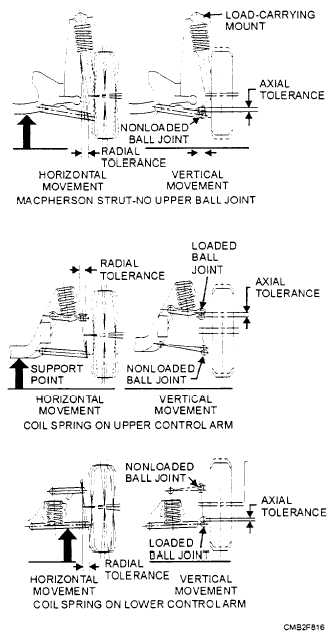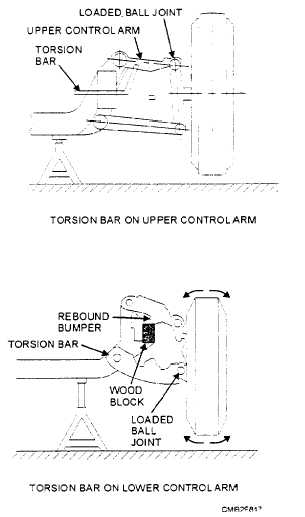Ball joints can be checked for wear while the wheel is supported, as shown in figures 8-16 and 8-17. Axial play or tolerance, also called vertical movement, is checked by moving the wheel straight up and down. The actual amount of play in a ball joint is measured with a dial indicator. Figure 8-18 shows the dial indicator clamped to the lower control arm. The dial indicator tip rests against the leg of the steering knuckle. With a pry bar. try to raise and lower the steering knuckle. If you use too much force, the ball joint may give you a false reading. You want to measure the movement of the wheel and ball joint, as the joint is moved up to the LOAD position. Note the movement as indicated on the dial indicator.

Figure 8-16. - Support points for checking ball joints in various front suspension systems using coil springs.
Rocking the wheel in and out at the top and bottom checks radial play or tolerance. This action also is known as horizontal movement. Grasp the tire at the top and bottom, and try to wobble it. However, now we are assuming that the wheel bearings have been checked and either adjusted or properly tightened. Therefore, we are now checking the horizontal movement of the ball joints. Some manufacturers do not accept horizontal movement as an indicator of ball joint wear.
The actual specifications for allowable wear limits of the ball joints are listed in the manufacturer's service manual. Refer to the specifications for the vehicle you are checking. Any ball joint should be replaced if there is excessive play.
Ball joint replacement can usually be done without removing the control arm. Generally, place the vehicle on jack stands. Remove the shock absorber and install a spring compressor on the coil spring. Unbolt the steering knuckle and separate the steering knuckle and

Figure 8-17. - Support points for checking ball joints in front suspension system using torsion bars.
Continue Reading